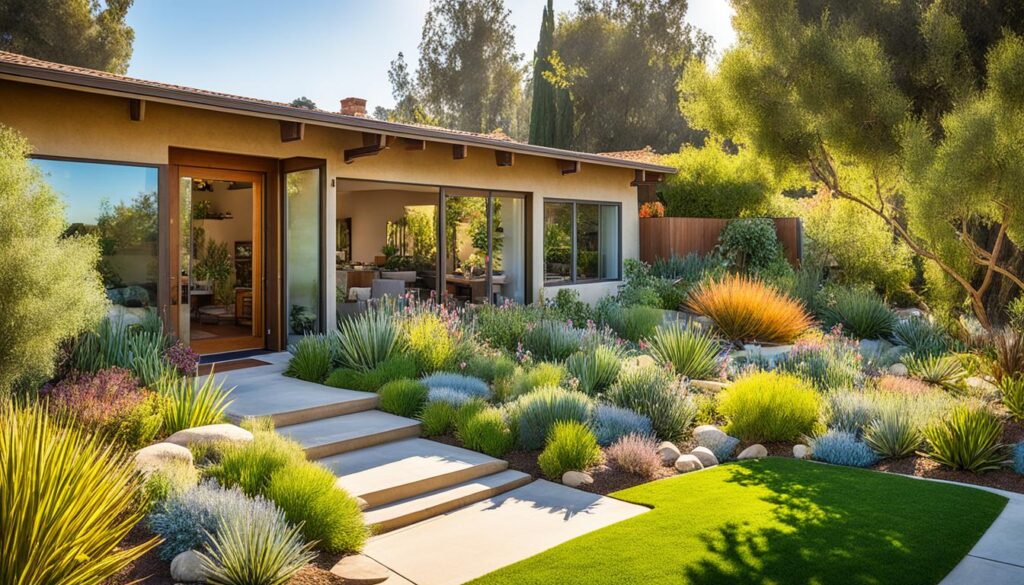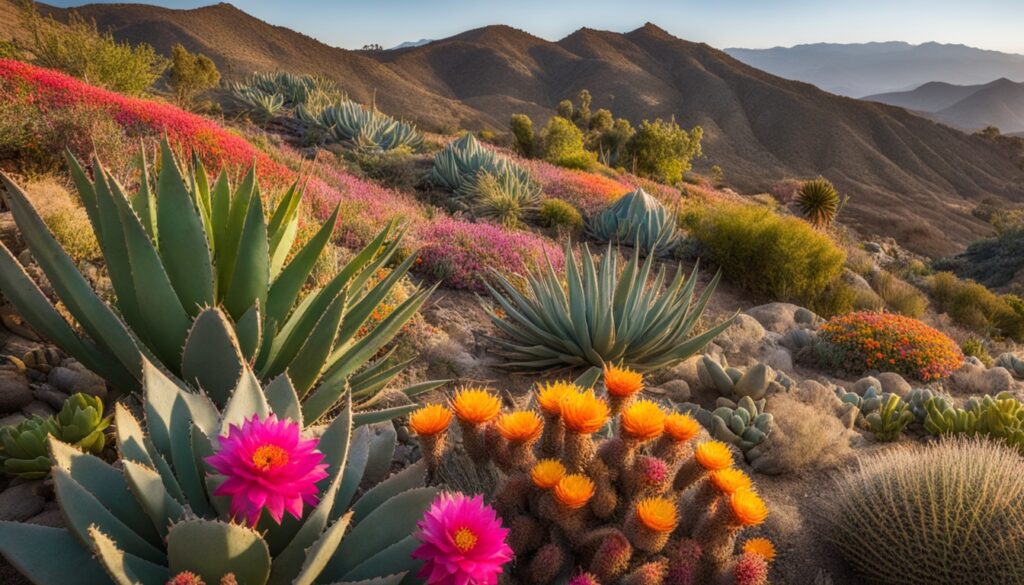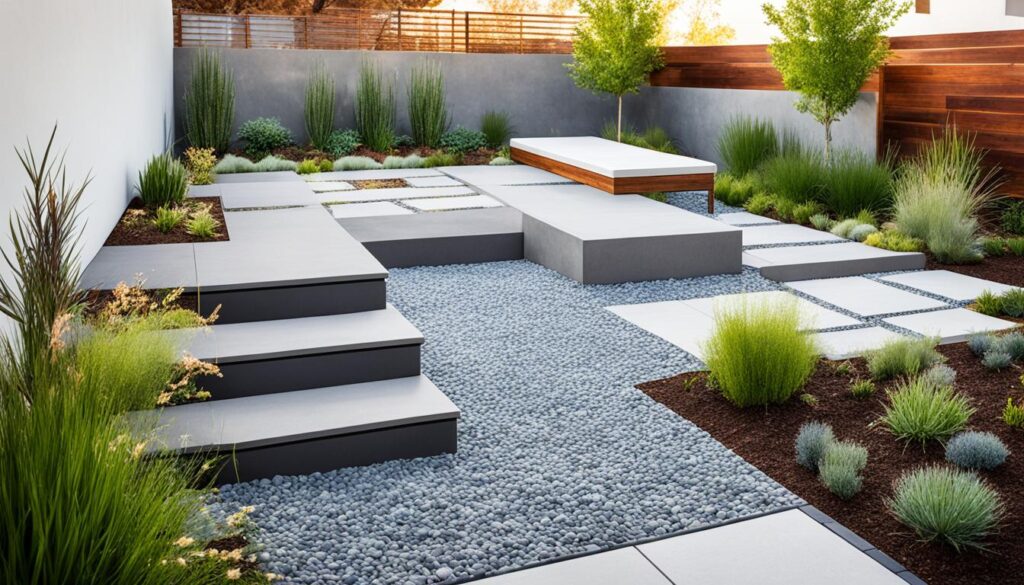
Did you know small engines for lawn care are very dirty? They are still allowed in California. Changing regular lawns into green spaces is smart for the planet and your wallet. LA’s eco landscaping saves water, lowers waste, and makes beautiful areas that fit California’s weather.
LA’s hot summers and cool winters make traditional gardens unwise. Using green landscaping cuts down on harm to nature. Techniques like xeriscaping and composting help design outdoor areas that are better for the environment.
Choosing a sustainable landscaping method in California saves resources. It helps native wildlife by using local plants. Plants like California Buckwheat and Purple Sage draw in animals and resist drought.
Making mulch from wood waste and recycling grass reduces yard waste and costs. Green landscaping helps the planet, your budget, and how your place looks.
LA’s homeowners and property managers want green solutions. Ideas like collecting rainwater and choosing plants that need less water are leading the way. These methods raise property values and help save water in a dry area.
Learn how to make your outdoor area green. These ideas promise beauty and a balanced ecosystem for LA homes.
Sustainable Landscaping Practices
Sustainable landscaping keeps our resources in check and helps the planet. In Los Angeles, using less water and more plants is key. This makes our cities healthier and better places to live.

Water Conservation Techniques
Saving water is at the heart of eco-friendly landscaping. We use clever ideas like drip irrigation, catching rainwater, and smart controllers to use less water. Choosing the right plants and watering methods also helps save our precious resource.
- Drip Irrigation: An efficient method of delivering water directly to plant roots, minimizing evaporation and ensuring optimal water usage.
- Rainwater Harvesting: Collecting and storing rainwater for landscape irrigation reduces reliance on municipal water supplies.
- Smart Irrigation Controllers: These devices adjust watering schedules based on weather conditions, further enhancing water conservation.
Xeriscaping
Xeriscaping uses plants that need less water to grow. This method cuts down on water use and yard waste. Practices like grasscycling help the soil stay moist and healthy.
Mulching and Composting
Mulching and composting are key to keeping soil moist and rich. Mulch keeps plant roots warm and stops weeds. Composting feeds the soil, making plants grow strong in California’s thick clay.
- Mulching: Utilizing organic material such as wood chips or leaves to retain soil moisture and suppress weeds.
- Composting: Decomposing organic matter to create nutrient-rich soil, improving plant health and soil structure.
Using expert landscaping ideas, like stopping erosion and capturing carbon, helps nature support itself. These methods let Los Angeles gardens flourish with less water, making a greener city for us all.
Utilizing Native Plants for Water Efficiency
Los Angeles landscapes need water-efficient plants due to droughts. Choosing plants that grow well here supports sustainable gardening.

Drought-Tolerant Species
Native plants for Los Angeles gardens, like California Mountain Lilac, Purple Sage, and Manzanita, save water. They look good and need less care and water. They also follow water use rules.
These plants fight pests and diseases with fewer chemicals. This makes them great for your garden.
Here are some key benefits of using these plants:
- Water conservation
- Reduced maintenance
- Enhanced curb appeal
- Increased property value
Creating Habitat
Native plants also make homes for local wildlife. They’re great for urban gardening for sustainability. They support birds, pollinators, and other wildlife.
They help maintain soil and reduce the need for artificial fertilizers. This makes gardens more sustainable.
Using native plants saves water and helps the environment. It makes Los Angeles gardens better for everyone.
Sustainable Landscaping Ideas for LA Properties
Los Angeles property owners are now focusing more on eco-friendly landscaping. They aim for beauty that doesn’t harm the environment. This means working with the local weather and nature.
Sustainable Hardscaping Solutions
Using sustainable hardscaping solutions is great. Things like permeable pavers and water features look good and are practical. They save water and cut down on care and costs.
Permeable materials for patios can reduce water runoff. This makes floods less likely and keeps water cleaner.

Water-Wise Gardens
Water-wise gardens pick plants that don’t need much water. They use smart soil and mulch to keep roots moist with less water. Practices like grasscycling and composting make soil better and save water.
These actions also help with California’s water challenges. They fight water shortage and pollution too.
Eco-Friendly Gardening Tips
Eco-friendly gardening tips include making a rock garden. Use drought-tolerant plants and recycled things for beds or paths. Think about getting artificial grass.
Less pesticide means a healthier garden. Integrated Pest Management (IPM) is good for this. Also, use smart watering and collect rainwater to be more efficient.
Conclusion
Eco-friendly landscaping in LA plays a big role in water saving, ecosystem health, and city greenness. Practices like using less water, xeriscaping, mulching, and composting make a big difference. These help make outdoor areas better for the environment.
Choosing local plants helps save water, cuts costs, and is good for local wildlife and nature. Drought-resistant plants are great for LA, saving even more water. Also, using special surfaces that let rain soak into the ground reduces runoff.
Modern LA backyards are getting creative with vertical gardens, smart furniture, and green materials. They’re blending simple and country styles in new, sustainable ways. By picking these green options, LA folk can have backyards that look good, work well, and care for the planet and climate. This green focus is key for a brighter, greener future in gardening.